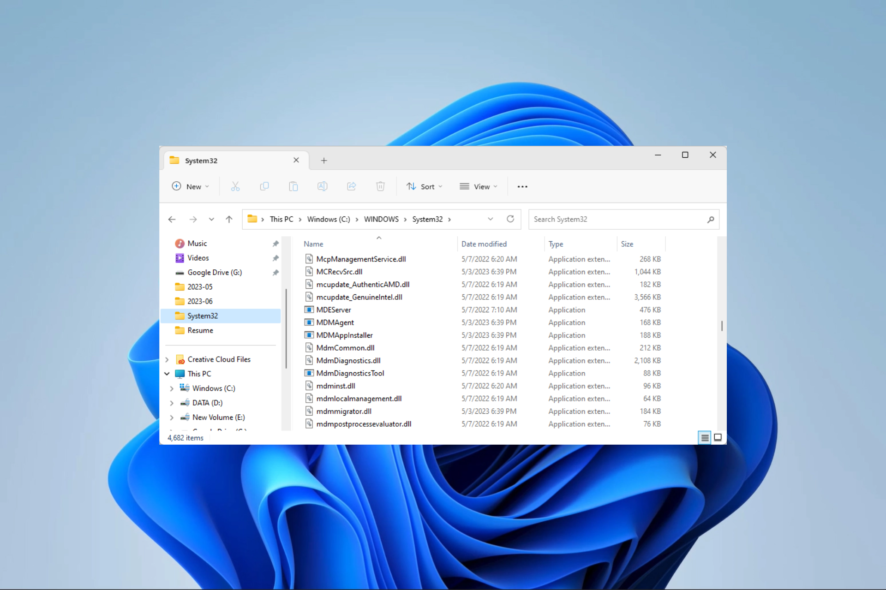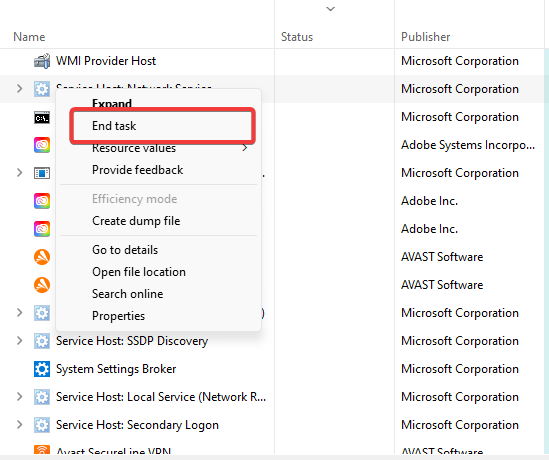What is mDNSResponder.exe & Should You Disable It?
The program is integral to the Multicast DNS protocol
4 min. read
Updated on
Read our disclosure page to find out how can you help Windows Report sustain the editorial team Read more
Key notes
- mDNSresponder.exe is a Multicast DNS (mDNS) protocol process and facilitates device discovery.
- It's related to Bonjour, Apple's implementation of mDNS, and enables easy network setup and service discovery.

You must have found this guide because you stumbled upon the mDNSResponder.exe file on your computer.
Many files, processes, and services are running on Windows, and many are wondering how many processes should be running on Windows. However, we answered that in a separate guide.
Today, we’ll focus solely on the file at hand, so let’s get started.
What is mDNSResponder on Windows?
The Windows process called mDNSResponder.exe is used to carry out the Multicast Domain Name Service (mDNS) protocol. Devices on a local network may find each other and accessible services using the networking protocol, requiring zero setups.
Small enterprises and household networks both frequently utilize it. Some mobile devices, like iPhones and iPads, also employ mDNS.
Also, it often concerns Bonjour, Apple’s version of mDNS that makes it simple to set up networks and find services across various devices. If you ever want to know what is the Bonjour service, we have a special guide that will answer all your questions.
Is mDNSResponder.exe a virus?
mDNSResponder.exe is not a virus, to be precise. It is an authorized procedure connected to the Multicast DNS (mDNS) protocol.
However, it’s essential to remember that certain malware and viruses may try to blend in by using a name or location for their files similar to mDNSResponder.exe. This can make it challenging to distinguish between a genuine process and one that might be malicious.
We always recommend running scans with an efficient antivirus software to clear any doubts.
What applications require mDNS?
- iTunes – iTunes searches the network for AirPlay-capable devices using mDNS. This enables you to wirelessly broadcast audio and video content from your computer to AirPlay-compatible speakers, TVs, and receivers.
- AirPort – To find other AirPort devices on the network, AirPort utilizes mDNS. This simplifies setting up a wireless network and sharing resources like files and printers.
- Bonjour – mDNS is a technology that Bonjour employs to find devices and services on a network. As a result, connecting to printers, file sharing, and other devices is simple and doesn’t require manual configuration.
- Printer sharing – On a local network, mDNS may share printers. By doing this, you may print to any printer on the network, regardless of whether it is attached to your computer.
- File sharing – A local network can transfer files using mDNS. By doing this, you may access files from other networked computers without explicitly mapping their disks.
- Media streaming – On a local network, media assets like music and videos can be streamed via mDNS. This enables you to watch movies or listen to music on any networked device, even one that isn’t directly linked to your computer.
- Gaming – On a local network, games may be played using mDNS. By doing so, you may play games and connect to other players without manually setting up your network settings.
How do you disable mDNSResponder.exe?
Use Task Manager
- Press Ctrl + Shift + Esc to open the Task Manager.
- Click on the Processes tab.
- Right-click on mDNSresponder.exe and select End task.
You may read our guide on opening the Task Manager if you run into any challenges while trying to disable the process.
Should you disable mDNSResponder.exe?
While there may be circumstances when mDNSresponder.exe needs to be disabled or is desirable, it’s important to weigh the possible effects first, which include:
While there may be scenarios where disabling mDNSresponder.exe is necessary or desired, it is crucial to consider the potential implications before doing so, which include:
- Resource usage and system performance – mDNSresponder.exe typically uses very little system resources when running effectively in the background. Unless particular problems or conflicts occur, disabling it just for system performance improvement will not result in noticeable improvements.
- Compatibility issues – Due to incompatibilities with other networking protocols or apps, you may think about turning off mDNSresponder.exe. Before choosing to disable mDNS capabilities, it is crucial to consider how doing so may affect network connectivity and local service discovery.
There you have it; all the important details surrounding the mDNSresponder.exe file. Rather than disable mDNSResponder.exe to conserve system resources, you may choose to disable some other background processes.
Lastly, if you have any questions, don’t hesitate to contact us via the comments section; we will gladly resolve the concerns.










